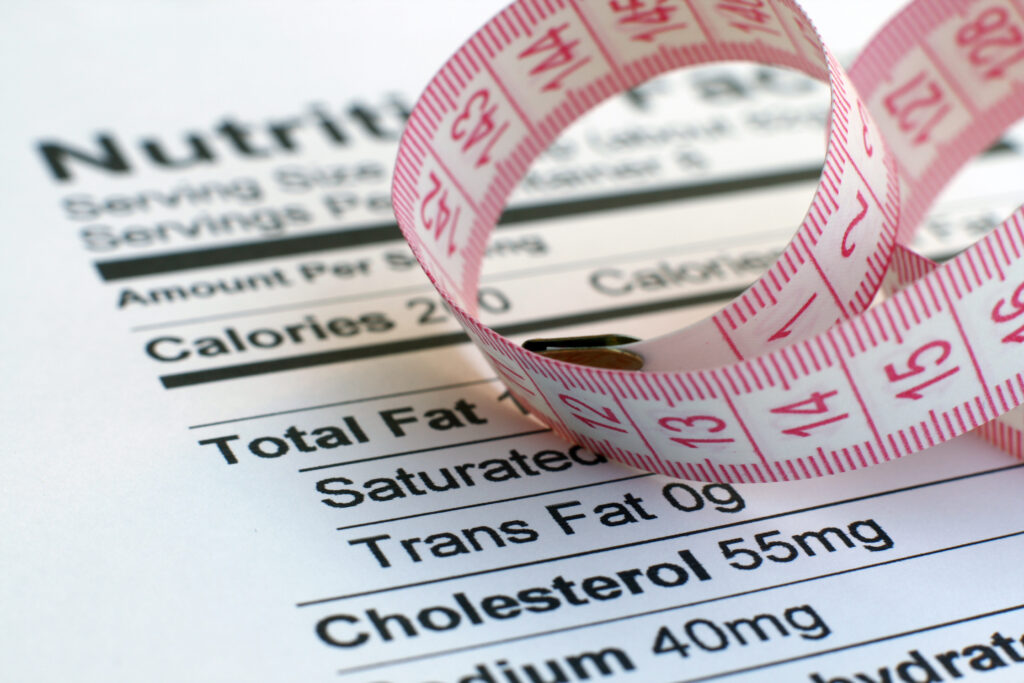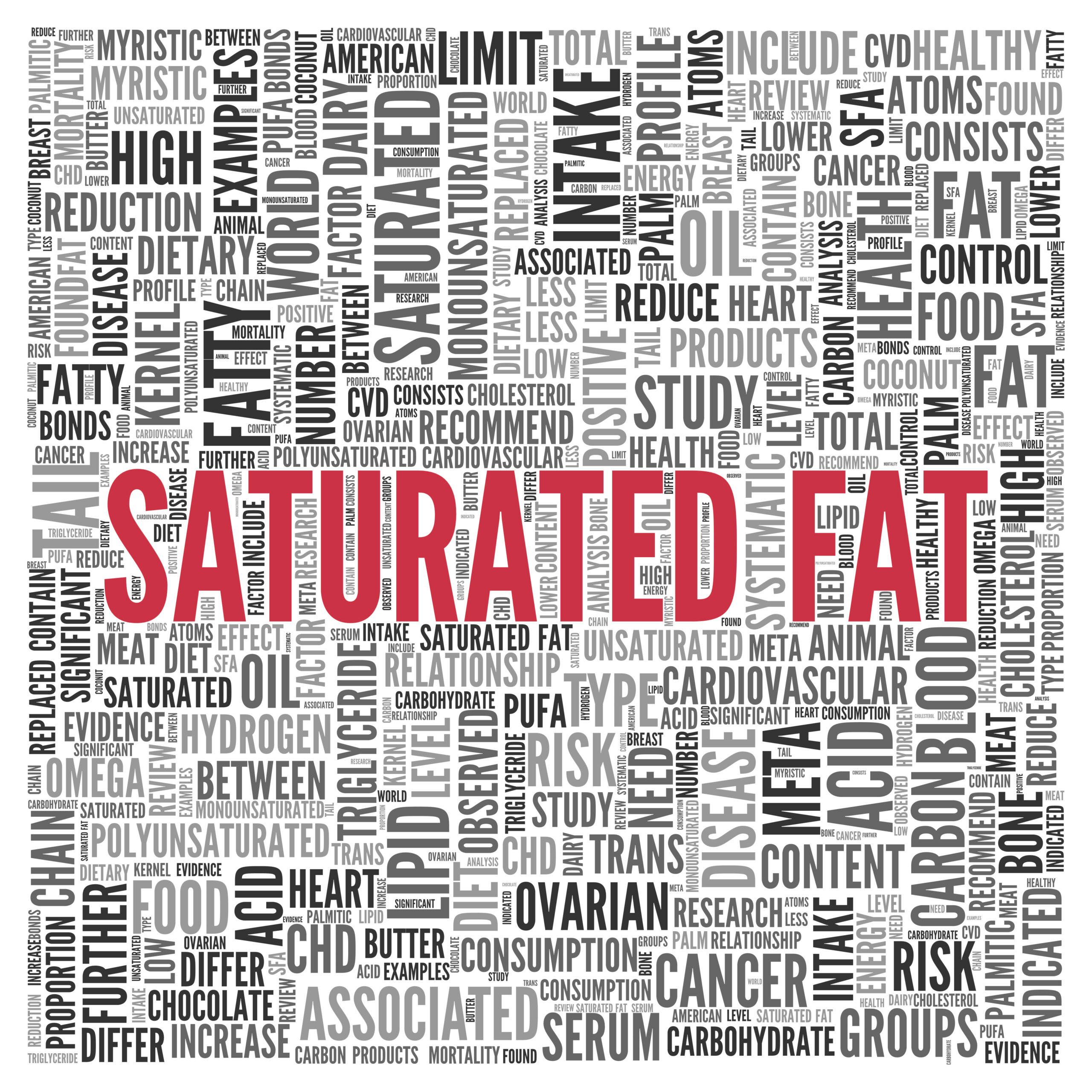Fat is one of three macronutrients, along with carbohydrates and protein, which provide energy to fuel our bodies. There are three types of dietary fats: unsaturated, saturated, and trans fats.
You often hear about healthy fats vs unhealthy fats. When we talk about healthy fats, we’re talking about mono- and polyunsaturated fats. Saturated fats and trans fats fall into the unhealthy or “bad fat” category.
You may be wondering: what is the difference between saturated and unsaturated fats? The answer is in the chemical composition of these fats, which determines how your body metabolizes them. This article will give you an overview of saturated fats, what foods contain them, and how they impact health.
What Are Saturated Fats?
Saturated fats get their names from their chemical composition. All fats are made from molecules of carbon, hydrogen, and oxygen. The arrangement of carbon and hydrogen molecules and how they are joined together determines the type of fat.
These fats contain single bonds between molecules and are “saturated” with hydrogen molecules. Unsaturated fats contain double bonds between molecules. Monounsaturated fats have only one double bond in their structure and polyunsaturated fats contain more than one double bond.
There are different types of saturated fats, which have different effects on the body. They are classified based on the length of the fatty acid, which can be short, medium, or long-chain.
The chemical structure of saturated fats causes them to be solid at room temperature, whereas unsaturated fats are liquid at room temperature. Examples of solid fats include butter and coconut oil. Olive oil is an example of liquid unsaturated fat.
Saturated Fat and Your Heart Health
Your body needs fat, but eating too much saturated fat can increase your risk factors for cardiovascular disease (CVD). Higher intakes have been linked to increases in several markers of heart health, including triglycerides, LDL cholesterol, and apolipoprotein B.
Elevated triglycerides and LDL cholesterol increase the risk of plaque buildup in arteries, called atherosclerosis. Plaque causes a narrowing of blood vessels, which can raise the risk of hypertension, stroke, and heart attack.
Apolipoprotein B (ApoB) is a protein that attaches to plaque forming LDL cholesterol. High levels of ApoB are linked to an increased risk of heart disease. Research suggests ApoB is a more reliable assessor of an individual’s heart disease risk. You can have your levels of ApoB checked with an advanced cardiac lipid panel.
Researchers have associated diets high in saturated fat with higher rates of mortality. Some evidence also suggests excess intake increases systemic inflammation, cancer risk, and insulin resistance. Foods with saturated fat tend to be high in total fat and calories, which can also contribute to unwanted weight gain.
Saturated Fat Recommendations
Because this type of fat can negatively impact health and raise your risk of heart disease, official health and nutrition organizations have set guidelines for daily recommended intake.
The Dietary Guidelines for Americans recommends limiting saturated fat intake to 10% of total daily calories. The American Heart Association recommends limiting intake to 5% of total daily calories.
First, all fats contain 9 calories per gram. There are 9 calories in every gram of saturated fat you consume. Here’s how to calculate saturated fat as a percentage of daily total calories:
- Determine how many grams of saturated fat you eat in a day.
- Calories from saturated fat = grams of saturated fat per day X 9 calories per gram of saturated fat
- Percent of calories from saturated fat = calories from saturated fat ➗ total daily calories X 100%
Here’s an example using an intake of 35 grams of saturated fat and 2,200 calories.
- 35 grams of saturated fat X 9 calories per gram = 315 calories of saturated fat
- 315 calories ➗ 2,200 calories = 0.14 X 100% = 14%
In the example above, saturated fat intake is 14% of total daily calories, more than the recommended 5-10% range. Remember, these recommendations are generalized. Individuals with familial hypercholesterolemia and other genetic metabolism disorders may need to keep their intake even lower.
The amount of saturated fat you can eat will be determined by your health history, genetics, and blood work. A registered dietitian who specializes in heart disease can help you determine exactly how much to allow in your diet.
Sources of Saturated Fats
Saturated fats are primarily found in animal foods and tropical oils. Foods high in saturated fat include:
- Meat and poultry- fatty cuts of beef and pork, skin-on poultry, bacon, sausage
- Full-fat dairy – cream, half and half, whole milk, cheese, butter, ice cream
- Lard
- Tallow
- Shortening
- Coconut oil
- Palm oil
In addition to these foods, processed and convenience foods also contain saturated fat. Baked goods, fast food, and fried foods often contain a significant amount of saturated fat.
Saturated fat can also add up from large portions of heart healthy fats as well, and we need to assess the total saturated fat from all food sources to understand your daily limit.

Does chicken have saturated fat?
People often become confused by saturated fat in meat and other proteins. On the one hand, animal foods, like meat and dairy, are convenient sources of protein that supports lean muscle mass and enhances satiety. On the other hand, they contain saturated fats. Are these foods healthy or not?
As mentioned above, fatty cuts of red meat and poultry with the skin contain saturated fat. Choosing more lean proteins, such as top sirloin or boneless and skinless chicken breasts, can help you consume less saturated fat.
Chicken does contain some saturated fat, but the amount depends on the type of chicken. White meat and skinless cuts contain less saturated fat than dark meat and chicken with skin on.
Here’s the saturated fat content in several cuts of chicken:
- 3-ounces chicken breast without skin: Less than 1 gram saturated fat
- 3-ounces chicken breast with skin: 2 grams saturated fat
- 3-ounces chicken thighs with skin: 3.49 grams saturated fat
- 3-ounces chicken wings with skin: 4.23 grams saturated fat
Are eggs high in saturated fat?
Eggs do contain some fat, but they are not considered a high-fat food. A single large egg contains about 5 grams of total fat. Of that, only 1 gram is saturated fat and the rest is unsaturated. The fat is found in the yolk of the eggs, so egg whites do not contain any saturated fat.
Tips for Reducing Saturated Fat Intake
Dietary fat provides our bodies with energy, helps us absorb fat-soluble vitamins and fat-soluble antioxidants, and is necessary for hormone production and normal cell function.
Instead of trying to remove all saturated fat from your diet, focus on including more healthy, unsaturated fats. Replacing foods high in saturated fats with foods that contain unsaturated fats is linked to a number of health benefits, including reduced risk of CVD and less weight gain as you age.
Some healthy fats, such as avocado and nuts, contain mostly unsaturated fats along with a small amount of saturated fat. Although these foods are better for you choices, they need to be portion controlled to keep your intake of saturated fats low.
Try these easy food swaps to reduce your intake of saturated fats:
- Cook with avocado oil instead of butter, coconut oil, or lard
- Remove skin from poultry
- Trim visible fat from meat
- Bake, roast, or saute instead of frying foods
- Choose plain, fat-free or low-fat milk, cottage cheese, and yogurt instead of whole milk versions
- Replace some of the ground beef in recipes, such as meat sauce, with beans, lentils, or mushrooms
- Replace the butter in baked goods with mashed avocado or unsweetened applesauce
Following a heart-healthy cardiac diet can help you optimize fat intake. Eating a diet based on unprocessed foods, such as vegetables, fruit, whole grains, nuts, seeds, and lean proteins is naturally low in saturated fat and can help support overall health.
Bottom Line
You need fat in your diet for good health, but not all fats are created equal. Eating too many saturated fats can raise your risk of heart disease and other health problems.
The goal is not to remove all traces of saturated fat from your diet. Rather, let’s focus on choosing foods that contain healthy fats and other nutrients that will support your heart health and individual goals.
As a cardiac dietitian, I can help you determine your daily goal for saturated fat intake, recommend therapeutic foods to replace sources of less-than ideal fats, and improve overall diet quality to support heart health. Let’s work together to create a customized plan for you. Get started by scheduling a 15-minute consultation.
References
References
1. Maki KC, Dicklin MR, Kirkpatrick CF. Saturated fats and cardiovascular health: Current evidence and controversies. J Clin Lipidol. 2021;15(6):765-772. doi:10.1016/j.jacl.2021.09.049
2. Behbodikhah J, Ahmed S, Elyasi A, et al. Apolipoprotein B and Cardiovascular Disease: Biomarker and Potential Therapeutic Target. Metabolites. 2021;11(10):690. Published 2021 Oct 8. doi:10.3390/metabo11100690
3. Kim Y, Je Y, Giovannucci EL. Association between dietary fat intake and mortality from all-causes, cardiovascular disease, and cancer: A systematic review and meta-analysis of prospective cohort studies. Clin Nutr. 2021;40(3):1060-1070. doi:10.1016/j.clnu.2020.07.007
4. Fritsche KL. The science of fatty acids and inflammation. Adv Nutr. 2015;6(3):293S-301S. Published 2015 May 15. doi:10.3945/an.114.006940
5. USDA FoodData Central Search Results: Chicken breast without skin. FoodData Central. Available at: https://fdc.nal.usda.gov/fdc-app.html#/food-details/171140/nutrients
6. USDA FoodData Central Search Results: Chicken breast with skin. FoodData Central. Available at: https://fdc.nal.usda.gov/fdc-app.html#/food-details/171075/nutrients
7. USDA FoodData Central Search Results: Chicken thighs. FoodData Central. Available at: https://fdc.nal.usda.gov/fdc-app.html#/food-details/173625/nutrients
8. USDA FoodData Central Search Results: Chicken wings. FoodData Central. Available at: https://fdc.nal.usda.gov/fdc-app.html#/food-details/173630/nutrients
9. USDA FoodData Central Search Results: Egg. FoodData Central. Available at: https://fdc.nal.usda.gov/fdc-app.html#/food-details/173424/nutrients
10. Hooper L, Martin N, Abdelhamid A, Davey Smith G. Reduction in saturated fat intake for cardiovascular disease. Cochrane Database Syst Rev. 2015;(6):CD011737. Published 2015 Jun 10. doi:10.1002/14651858.CD011737
11. Liu X, Li Y, Tobias DK, et al. Changes in Types of Dietary Fats Influence Long-term Weight Change in US Women and Men. J Nutr. 2018;148(11):1821-1829. doi:10.1093/jn/nxy183
